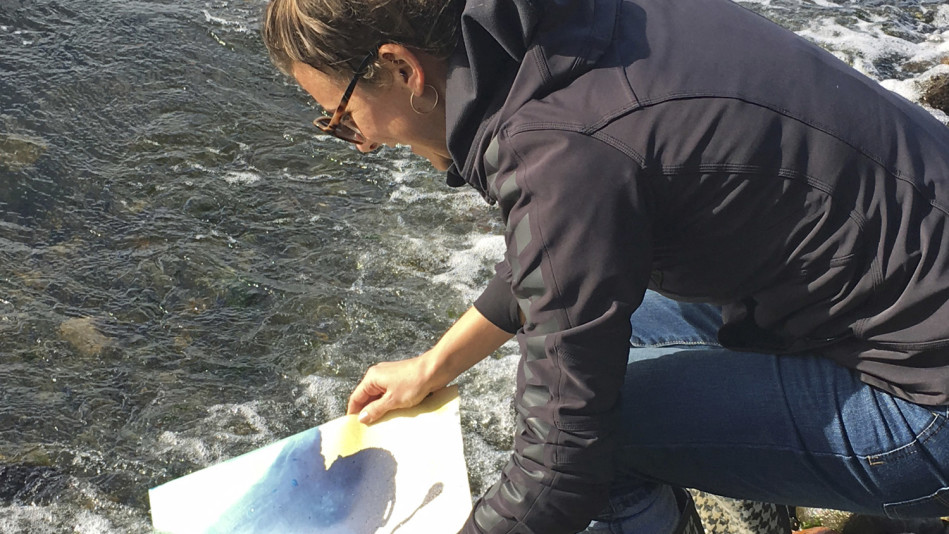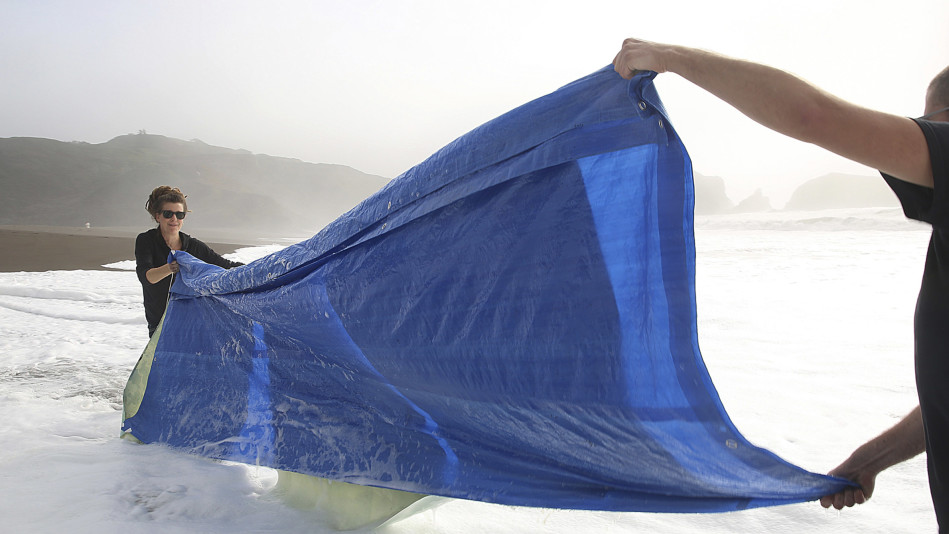This Artist Uses Water to Create Stunning Works of Art
Artist Meghann Riepenhoff knows how to go with the flow.

Photo: Paul Morse
Like any good landscape photographer, Meghann Riepenhoff relies on perspective, light and location to capture striking scenes of the natural world. What she doesn't rely on is a camera. That's because the un-shutterbug works with cyanotype, a printing process in which paper or canvas treated with a photosensitive chemical solution is exposed to UV light (usually sunlight), resulting in blueprintlike pictures. Riepenhoff's twist on the 19th-century technique: allowing earthy elements—sand, silt, coarse grains of salt, flecks of dirt—to leave their mark on her arresting pieces. "Time, weather, and movement are always embedded in the final image," she says. "If a print was placed in wild surf, it'll be covered in splashes of salt-spray whites and aquatic blues. But photos created in a pool will have a smooth wash."

Letting water rush over a canvas on Bainbridge Island, Washington.
"The best part about being an artist is having the freedom to feed your curiosity," says Riepenhoff, 37. "I've been captivated by light and bioluminescent creatures—light-up animals like fireflies and jellyfish—since I was a kid." In 2012, she traveled from California to Hilton Head, South Carolina, to document bioluminescent water at Tower Beach. "The plan was to submerge photo paper in the neon blue ocean and record this magical luminosity," says Riepenhoff. The problem: She arrived at the wrong time to catch the fleeting glimmer. Determined to make her trip worthwhile despite the snafu, Riepenhoff went ahead and dunked her paper into dark water. To her surprise, a swirling pastel landscape popped up. "Cyanotype has a deep connection to the ocean because some of the first pictures documented coastal flora and fauna," she says, "so I thought, Why not bring the form back to the beach?"

Riepenhoff and her assistant capturing an image at California's Rodeo Beach.
Riepenhoff has a studio on Bainbridge Island, Washington, but her real work space is anywhere near ponds, rivers, lakes, or seas. "My assistant and I might hold paper vertically so waves crash into it," she says. "Or maybe we float a sheet on top of the surf so water can rush over it. Or I might let raindrops stream down a panel." Then, using rocks or sticks to stabilize her canvas, Riepenhoff leaves a print-to-be in place for anywhere from four hours to a week. But because she doesn't use a wash to fully process her photographs, they can continue to evolve. "The images can actually change throughout the day, lightening when exposed to intense sun and becoming darker at night," she says. "Some could even grow salt or develop rust."
Riepenhoff has made cyanotypes in more than 30 locations: Italian beaches, California's Mono Lake, even a residential pool in Atlanta. Each spot comes with different challenges. Unruly swells, gusty winds, and wandering pets all have tampered with Riepenhoff's work—which is just fine with her. "Creating art in the wild means being open to surprises," she says. But there is one occupational hazard Riepenhoff didn’t see coming. "My photos have ruined the possibility of taking a beach vacation," she says. "When I’m near water, I have to work!"
1843
Year that botanist Anna Atkins published her innovative book Photographs of British Algae: Cyanotype Impressions, believed to be the first-ever volume with photographically illustrated images.
Want more stories like this delivered to your inbox? Sign up for the Oprah.com Spirit Newsletter!

Letting water rush over a canvas on Bainbridge Island, Washington.
"The best part about being an artist is having the freedom to feed your curiosity," says Riepenhoff, 37. "I've been captivated by light and bioluminescent creatures—light-up animals like fireflies and jellyfish—since I was a kid." In 2012, she traveled from California to Hilton Head, South Carolina, to document bioluminescent water at Tower Beach. "The plan was to submerge photo paper in the neon blue ocean and record this magical luminosity," says Riepenhoff. The problem: She arrived at the wrong time to catch the fleeting glimmer. Determined to make her trip worthwhile despite the snafu, Riepenhoff went ahead and dunked her paper into dark water. To her surprise, a swirling pastel landscape popped up. "Cyanotype has a deep connection to the ocean because some of the first pictures documented coastal flora and fauna," she says, "so I thought, Why not bring the form back to the beach?"

Riepenhoff and her assistant capturing an image at California's Rodeo Beach.
Riepenhoff has a studio on Bainbridge Island, Washington, but her real work space is anywhere near ponds, rivers, lakes, or seas. "My assistant and I might hold paper vertically so waves crash into it," she says. "Or maybe we float a sheet on top of the surf so water can rush over it. Or I might let raindrops stream down a panel." Then, using rocks or sticks to stabilize her canvas, Riepenhoff leaves a print-to-be in place for anywhere from four hours to a week. But because she doesn't use a wash to fully process her photographs, they can continue to evolve. "The images can actually change throughout the day, lightening when exposed to intense sun and becoming darker at night," she says. "Some could even grow salt or develop rust."
Riepenhoff has made cyanotypes in more than 30 locations: Italian beaches, California's Mono Lake, even a residential pool in Atlanta. Each spot comes with different challenges. Unruly swells, gusty winds, and wandering pets all have tampered with Riepenhoff's work—which is just fine with her. "Creating art in the wild means being open to surprises," she says. But there is one occupational hazard Riepenhoff didn’t see coming. "My photos have ruined the possibility of taking a beach vacation," she says. "When I’m near water, I have to work!"
1843
Year that botanist Anna Atkins published her innovative book Photographs of British Algae: Cyanotype Impressions, believed to be the first-ever volume with photographically illustrated images.
Want more stories like this delivered to your inbox? Sign up for the Oprah.com Spirit Newsletter!



